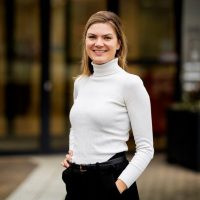Anthropogenic substances under scrutiny
What happens to substances that do not naturally belong in our environment? That question has fascinated Rianne van den Meiracker since she was a child. She is now a researcher at Deltares specialising in anthropogenic substances in groundwater and surface water, working daily to unravel the pathways, effects and solutions for these substances in water and soil.

Pesticides rightly require our attention
Anthropogenic substances are a broad category. Pesticides and PFAS are often in the news and rightly require our attention. They are not natural substances; they are chemical and man-made.
‘When you see a field of flowers and think how beautiful they look, you don’t think about the fact that pesticides are often used to grow them even more effectively. The substances spread through the air, through and across the soil, and eventually into the water. We map out those possible pathways through soil and water, whether or not because an exceedance of the relevant limit has been detected somewhere.'
'That helps administrators to take action where it will have most effect. Because once these substances get into the natural environment, they have undesirable effects. Natural flora and fauna often can’t cope. Water quality deteriorates and many of the substances don’t break down easily. In addition, as long as we don’t know whether human health is affected, we prefer not to see too many pesticides in water, soil and air.’
In her projects, Van den Meiracker works closely with a range of water authorities and their laboratories, but also with different knowledge institutes such as the RIVM.

Measuring, understanding and controlling PFAS
Since 2019, Deltares has been studying PFAS, a group of chemicals that bond to sediment and that break down with difficulty. During a major monitoring campaign in the Rotterdam port area, Deltares looked at how PFAS are released during dredging operations and spread in the water system.
‘Fortunately, I don’t spend all my time in an office and I sometimes get to go out into the field, such as when there was a major monitoring campaign in the Rotterdam port area to investigate the presence of PFAS substances in sediment. PFAS substances bond to the sediment that is regularly dredged in the port area. The question is whether those PFAS are then released again and, if so, at what depth. Ultimately, studies like this provide us with more knowledge about the spread of PFAS through the water and soil system as well, which is why Rijkswaterstaat, the Port Authority and the dredging company were also involved in this campaign. This is knowledge they will ultimately apply,’ says Van den Meiracker.

Sunflowers on the campus
In addition, Deltares is working on innovative remediation methods, such as using plants (sunflowers, willows and reeds, for example) to remove PFAS from the environment. We are growing sunflowers on the campus in Delft that take up a lot of water. This is important for cleaning up old industrial areas.
‘There is often still a lot of stuff in the soil and groundwater there, including PFAS. We are looking to see whether we can clean up groundwater faster by using the roots of plants. We are doing this at a large-scale remediation location where groundwater contaminated with PFAS is used to water plants. We are also currently conducting a regulated experiment using only sunflowers on our campus. Sunflowers grow fast and they have the potential to absorb a lot of PFAS in a short period of time.'
'In this way, we can conduct a controlled study of the conditions that produce the best results. The idea is to obtain results faster that way, which then can be used at the remediation location. In this way, we are trying to use natural solutions to improve the groundwater and surface water, soil and ultimately the locality of those sites.’

Like me, you can work in your own role to assume responsibility for the quality of our water and soil system.
Rianne van den Meiracker, researcher anthropogenic substances
Deltares is therefore inviting knowledge institutes, government authorities and laboratories to team up in order to better understand and control anthropogenic substances.

